'Forbidden Planet' found by astronomers in Neptunian Desert
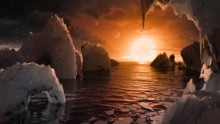
Photos: Weird and wonderful planets beyond our solar system
An artist's concept image of the surface of the exoplanet TRAPPIST-1f. Of the seven exoplanets discovered orbiting the ultracool dwarf star TRAPPIST-1, this one may be the most suitable for life. It is similar in size to Earth, is a little cooler than Earth's temperature and is in the habitable zone of the star, meaning liquid water (and even oceans) could be on the surface. The proximity of the star gives the sky a salmon hue, and the other planets are so close that they appear in the sky, much like our own moon.
Hide Caption
18 of 35
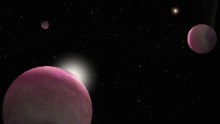
Photos: Weird and wonderful planets beyond our solar system
Artist's conception of the binary system with three giant planets discovered, where one star hosts two planets and the other hosts the third. The system represents the smallest-separation binary in which both stars host planets that has ever been observed.
Hide Caption
19 of 35
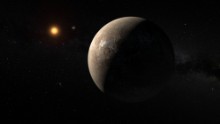
Photos: Weird and wonderful planets beyond our solar system
This artist's impression shows the planet Proxima b orbiting the red dwarf star Proxima Centauri, the closest star to our solar system.
Hide Caption
20 of 35

Photos: Weird and wonderful planets beyond our solar system
This artist's impression shows a view of the surface of the planet Proxima b.
Hide Caption
21 of 35
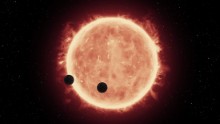
Photos: Weird and wonderful planets beyond our solar system
An artist's rendering shows Earth-sized exoplanets TRAPPIST-1b and 1c in a rare double transit event as they pass in front of their ultracool red dwarf star, which allowed Hubble to take a peek at at their atmospheres.
Hide Caption
22 of 35
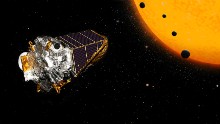
Photos: Weird and wonderful planets beyond our solar system
Out of a new discovery of 104 exoplanets, astronomers found four similar in size to Earth that are orbiting a dwarf star. Two of them have the potential to support life. The craft depicted in this illustration is the NASA Kepler Space Telescope, which has helped confirm the existence of thousands of exoplanets.
Hide Caption
23 of 35
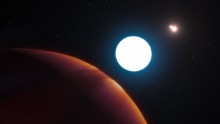
Photos: Weird and wonderful planets beyond our solar system
This artist's impression shows a view of the triple-star system HD 131399 from close to the giant planet orbiting in the system. Located about 320 light-years from Earth, the planet is about 16 million years old, making it also one of the youngest exoplanets discovered to date.
Hide Caption
24 of 35
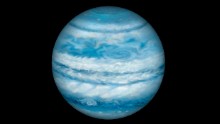
Photos: Weird and wonderful planets beyond our solar system
An artistic impression of the planet Kepler-1647b, which is nearly identical to Jupiter in both size and mass. The planet is expected to be roughly similar in appearance. But it is much warmer: Kepler-1647b is in the habitable zone.
Hide Caption
25 of 35
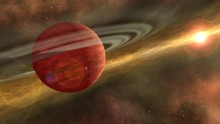
Photos: Weird and wonderful planets beyond our solar system
HD-106906b is a gaseous planet 11 times more massive than Jupiter. The planet is believed to have formed in the center of its solar system, before being sent flying out to the edges of the region by a violent gravitational event.
Hide Caption
26 of 35
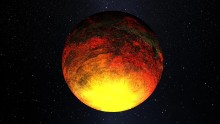
Photos: Weird and wonderful planets beyond our solar system
Kepler-10b orbits at a distance more than 20 times closer to its star than Mercury is to our own sun. Daytime temperatures exceed 1,300 degrees Celsius (2,500 degrees Fahrenheit), which is hotter than lava flows on Earth.
Hide Caption
27 of 35
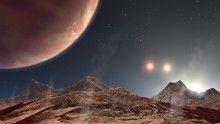
Photos: Weird and wonderful planets beyond our solar system
This Jupiter-like planet in the HD-188753 system, 149 light-years from Earth, has three suns. The main star is similar in mass to our own Sun. The system has been compared to Luke Skywalker's home planet Tatooine in "Star Wars."
Hide Caption
28 of 35
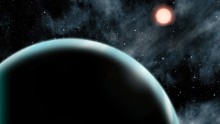
Photos: Weird and wonderful planets beyond our solar system
Kepler-421b is a Uranus-sized transiting exoplanet with the longest known year, as it circles its star once every 704 days. The planet orbits an orange, K-type star that is cooler and dimmer than our Sun and is located about 1,000 light-years from Earth in the constellation Lyra.
Hide Caption
29 of 35
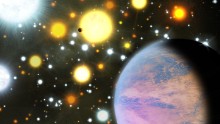
Photos: Weird and wonderful planets beyond our solar system
Astronomers discovered two planets less than three times the size of Earth orbiting sun-like stars in a crowded stellar cluster approximately 3,000 light-years from Earth in the constellation Cygnus.
Hide Caption
30 of 35
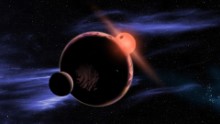
Photos: Weird and wonderful planets beyond our solar system
This artist's conception shows a hypothetical planet with two moons orbiting in the habitable zone of a red dwarf star. The majority of the sun's closest stellar neighbors are red dwarfs.
Hide Caption
31 of 35
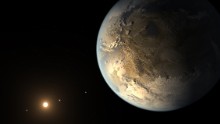
Photos: Weird and wonderful planets beyond our solar system
Kepler-186f was the first validated Earth-sized planet to be found orbiting a distant star in the habitable zone. This zone a range of distance from a star where liquid water might pool on the planet's surface.
Hide Caption
32 of 35
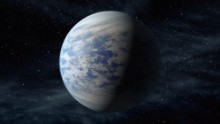
Photos: Weird and wonderful planets beyond our solar system
Kepler-69c is a super-Earth-size planet similar to Venus. The planet is found in the habitable zone of a star like our sun, approximately 2,700 light years from Earth in the constellation Cygnus.
Hide Caption
33 of 35
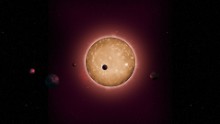
Photos: Weird and wonderful planets beyond our solar system
The Kepler-444 system formed when the Milky Way was just 2 billion years old. The tightly packed system is home to five planets that range in size, the smallest is comparable to the size of Mercury and the largest to Venus, orbiting their sun in less than 10 days.
Hide Caption
34 of 35
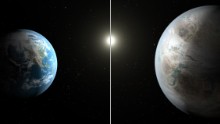
Photos: Weird and wonderful planets beyond our solar system
This artistic concept image compares Earth, left, with Kepler-452b, which is about 60% larger. Both planets orbit a G2-type star of about the same temperature; however, the star hosting Kepler-452b is 6 billion years old -- 1.5 billion years older than our sun.
Hide Caption
35 of 35

Photos: Weird and wonderful planets beyond our solar system
This is an artist's illustration of NGTS-4b, also known to astronomers as "The Forbidden Planet." It whips around its star every 1.3 days and still maintains a gaseous atmosphere in the Neptunian Desert, where no Neptune-sized planets are found.
Hide Caption
1 of 35
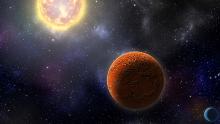
Photos: Weird and wonderful planets beyond our solar system
An artist's illustration of HD 21749c, the first Earth-size planet found by TESS, as well as its sibling, HD 21749b, a warm mini-Neptune.
Hide Caption
2 of 35
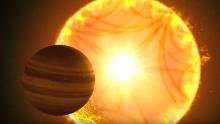
Photos: Weird and wonderful planets beyond our solar system
A "hot Saturn" passes in front of its host star in this illustration. Astronomers who study stars used "starquakes" to characterize the star, which provided critical information about the planet.
Hide Caption
3 of 35
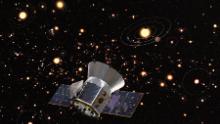
Photos: Weird and wonderful planets beyond our solar system
Artist's concept of TESS against background of stars & orbiting planets in the Milky Way. Credit: ESA, M. Kornmesser (ESO), Aaron E. Lepsch (ADNET Systems Inc.), Britt Griswold (Maslow Media Group), NASA's Goddard Space Flight Center & Cornell University
Hide Caption
4 of 35
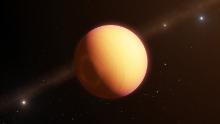
Photos: Weird and wonderful planets beyond our solar system
A super-telescope made the first direct observation of an exoplanet using optical interferometry. This method revealed a complex exoplanetary atmosphere with clouds of iron and silicates swirling in a planet-wide storm. The technique presents unique possibilities for characterizing many of the exoplanets known today.
Hide Caption
5 of 35
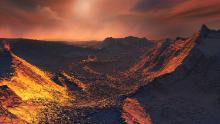
Photos: Weird and wonderful planets beyond our solar system
This image shows an artist's impression of the surface of Barnard's star b, a cold Super-Earth discovered orbiting Barnard's star 6 light-years away.
Hide Caption
6 of 35
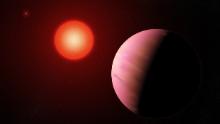
Photos: Weird and wonderful planets beyond our solar system
This artist's illustration shows newly discovered exoplanet K2-288Bb, 226 light-years away and half the size of Neptune. It orbits the fainter member of a pair of cool M-type stars every 31.3 days.
Hide Caption
7 of 35
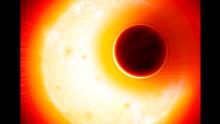
Photos: Weird and wonderful planets beyond our solar system
This is an artist's impression of the exoplanet HAT-P-11b. The planet has an extended helium atmosphere that's being blown away by the star, an orange dwarf star smaller but more active than our sun.
Hide Caption
8 of 35
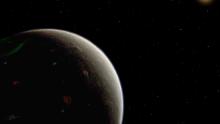
Photos: Weird and wonderful planets beyond our solar system
An artist's illustration of what the super-Earth found around the orange-hued star HD 26965 (also known as 40 Eridani A) might look like. The recently discovered exoplanet is being compared to the fictional planet of Vulcan because Star Trek creator Gene Roddenberry said the star was the ideal candidate to host Vulcan, Mr. Spock's home world.
Hide Caption
9 of 35
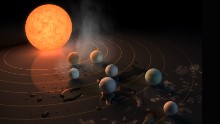
Photos: Weird and wonderful planets beyond our solar system
The TRAPPIST-1 star, an ultra-cool dwarf, has seven Earth-size planets orbiting it.
Hide Caption
10 of 35
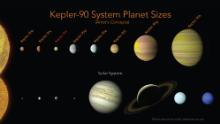
Photos: Weird and wonderful planets beyond our solar system
For the first time, eight planets have been found orbiting another star, tying with our solar system for the most known planets around a single star. The Kepler-90 system is in the constellation Draco, more than 2,500 light-years from Earth.
Hide Caption
11 of 35
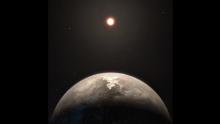
Photos: Weird and wonderful planets beyond our solar system
This artist's illustration shows exoplanet Ross 128 b, with its red dwarf host star in the background. The planet is only 11 light-years from our solar system. It is now the second-closest temperate planet to be detected, after Proxima b.
Hide Caption
12 of 35
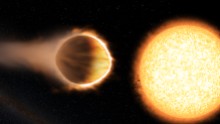
Photos: Weird and wonderful planets beyond our solar system
WASP-121b, 880 light-years away, is considered a hot Jupiter-like planet. It has a greater mass and radius than Jupiter, making it "puffier." If WASP-121b were any closer to its host star, it would be ripped apart by the star's gravity.
Hide Caption
13 of 35
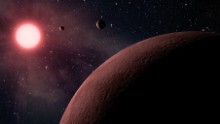
Photos: Weird and wonderful planets beyond our solar system
NASA's Kepler space telescope team has identified 219 more planet candidates, 10 of which are near-Earth size and in the habitable zone of their stars.
Hide Caption
14 of 35
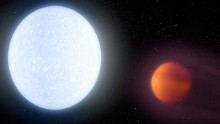
Photos: Weird and wonderful planets beyond our solar system
Welcome to the KELT-9 system. The host star is a hot, rapidly rotating A-type star that is about 2.5 times more massive and almost twice as hot as our sun. The hot star blasts its nearby planet KELT-9b with massive amounts of radiation, leading to a daylight temperature of 7800 degrees Fahrenheit, hotter that most stars and only 2000 degrees cooler than the sun.
Hide Caption
15 of 35
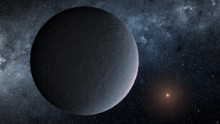
Photos: Weird and wonderful planets beyond our solar system
This artist's concept shows OGLE-2016-BLG-1195Lb, a planet orbiting an incredibly faint star 13,000 light-years away from us. It is an "iceball" planet with temperatures reaching minus-400 degrees Fahrenheit.
Hide Caption
16 of 35
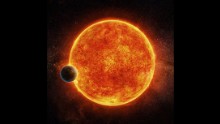
Photos: Weird and wonderful planets beyond our solar system
LHS 1140b is located in the liquid water habitable zone surrounding its host star, a small, faint red star named LHS 1140. The planet weighs about 6.6 times the mass of Earth and is shown passing in front of LHS 1140. Depicted in blue is the atmosphere the planet may have retained.
Hide Caption
17 of 35

Photos: Weird and wonderful planets beyond our solar system
An artist's concept image of the surface of the exoplanet TRAPPIST-1f. Of the seven exoplanets discovered orbiting the ultracool dwarf star TRAPPIST-1, this one may be the most suitable for life. It is similar in size to Earth, is a little cooler than Earth's temperature and is in the habitable zone of the star, meaning liquid water (and even oceans) could be on the surface. The proximity of the star gives the sky a salmon hue, and the other planets are so close that they appear in the sky, much like our own moon.
Hide Caption
18 of 35

Photos: Weird and wonderful planets beyond our solar system
Artist's conception of the binary system with three giant planets discovered, where one star hosts two planets and the other hosts the third. The system represents the smallest-separation binary in which both stars host planets that has ever been observed.
Hide Caption
19 of 35

Photos: Weird and wonderful planets beyond our solar system
This artist's impression shows the planet Proxima b orbiting the red dwarf star Proxima Centauri, the closest star to our solar system.
Hide Caption
20 of 35

Photos: Weird and wonderful planets beyond our solar system
This artist's impression shows a view of the surface of the planet Proxima b.
Hide Caption
21 of 35

Photos: Weird and wonderful planets beyond our solar system
An artist's rendering shows Earth-sized exoplanets TRAPPIST-1b and 1c in a rare double transit event as they pass in front of their ultracool red dwarf star, which allowed Hubble to take a peek at at their atmospheres.
Hide Caption
22 of 35

Photos: Weird and wonderful planets beyond our solar system
Out of a new discovery of 104 exoplanets, astronomers found four similar in size to Earth that are orbiting a dwarf star. Two of them have the potential to support life. The craft depicted in this illustration is the NASA Kepler Space Telescope, which has helped confirm the existence of thousands of exoplanets.
Hide Caption
23 of 35

Photos: Weird and wonderful planets beyond our solar system
This artist's impression shows a view of the triple-star system HD 131399 from close to the giant planet orbiting in the system. Located about 320 light-years from Earth, the planet is about 16 million years old, making it also one of the youngest exoplanets discovered to date.
Hide Caption
24 of 35

Photos: Weird and wonderful planets beyond our solar system
An artistic impression of the planet Kepler-1647b, which is nearly identical to Jupiter in both size and mass. The planet is expected to be roughly similar in appearance. But it is much warmer: Kepler-1647b is in the habitable zone.
Hide Caption
25 of 35

Photos: Weird and wonderful planets beyond our solar system
HD-106906b is a gaseous planet 11 times more massive than Jupiter. The planet is believed to have formed in the center of its solar system, before being sent flying out to the edges of the region by a violent gravitational event.
Hide Caption
26 of 35

Photos: Weird and wonderful planets beyond our solar system
Kepler-10b orbits at a distance more than 20 times closer to its star than Mercury is to our own sun. Daytime temperatures exceed 1,300 degrees Celsius (2,500 degrees Fahrenheit), which is hotter than lava flows on Earth.
Hide Caption
27 of 35

Photos: Weird and wonderful planets beyond our solar system
This Jupiter-like planet in the HD-188753 system, 149 light-years from Earth, has three suns. The main star is similar in mass to our own Sun. The system has been compared to Luke Skywalker's home planet Tatooine in "Star Wars."
Hide Caption
28 of 35

Photos: Weird and wonderful planets beyond our solar system
Kepler-421b is a Uranus-sized transiting exoplanet with the longest known year, as it circles its star once every 704 days. The planet orbits an orange, K-type star that is cooler and dimmer than our Sun and is located about 1,000 light-years from Earth in the constellation Lyra.
Hide Caption
29 of 35

Photos: Weird and wonderful planets beyond our solar system
Astronomers discovered two planets less than three times the size of Earth orbiting sun-like stars in a crowded stellar cluster approximately 3,000 light-years from Earth in the constellation Cygnus.
Hide Caption
30 of 35

Photos: Weird and wonderful planets beyond our solar system
This artist's conception shows a hypothetical planet with two moons orbiting in the habitable zone of a red dwarf star. The majority of the sun's closest stellar neighbors are red dwarfs.
Hide Caption
31 of 35

Photos: Weird and wonderful planets beyond our solar system
Kepler-186f was the first validated Earth-sized planet to be found orbiting a distant star in the habitable zone. This zone a range of distance from a star where liquid water might pool on the planet's surface.
Hide Caption
32 of 35

Photos: Weird and wonderful planets beyond our solar system
Kepler-69c is a super-Earth-size planet similar to Venus. The planet is found in the habitable zone of a star like our sun, approximately 2,700 light years from Earth in the constellation Cygnus.
Hide Caption
33 of 35

Photos: Weird and wonderful planets beyond our solar system
The Kepler-444 system formed when the Milky Way was just 2 billion years old. The tightly packed system is home to five planets that range in size, the smallest is comparable to the size of Mercury and the largest to Venus, orbiting their sun in less than 10 days.
Hide Caption
34 of 35

Photos: Weird and wonderful planets beyond our solar system
This artistic concept image compares Earth, left, with Kepler-452b, which is about 60% larger. Both planets orbit a G2-type star of about the same temperature; however, the star hosting Kepler-452b is 6 billion years old -- 1.5 billion years older than our sun.
Hide Caption
35 of 35

Photos: Weird and wonderful planets beyond our solar system
This is an artist's illustration of NGTS-4b, also known to astronomers as "The Forbidden Planet." It whips around its star every 1.3 days and still maintains a gaseous atmosphere in the Neptunian Desert, where no Neptune-sized planets are found.
Hide Caption
1 of 35

Photos: Weird and wonderful planets beyond our solar system
An artist's illustration of HD 21749c, the first Earth-size planet found by TESS, as well as its sibling, HD 21749b, a warm mini-Neptune.
Hide Caption
2 of 35

Photos: Weird and wonderful planets beyond our solar system
A "hot Saturn" passes in front of its host star in this illustration. Astronomers who study stars used "starquakes" to characterize the star, which provided critical information about the planet.
Hide Caption
3 of 35

Photos: Weird and wonderful planets beyond our solar system
Artist's concept of TESS against background of stars & orbiting planets in the Milky Way. Credit: ESA, M. Kornmesser (ESO), Aaron E. Lepsch (ADNET Systems Inc.), Britt Griswold (Maslow Media Group), NASA's Goddard Space Flight Center & Cornell University
Hide Caption
4 of 35

Photos: Weird and wonderful planets beyond our solar system
A super-telescope made the first direct observation of an exoplanet using optical interferometry. This method revealed a complex exoplanetary atmosphere with clouds of iron and silicates swirling in a planet-wide storm. The technique presents unique possibilities for characterizing many of the exoplanets known today.
Hide Caption
5 of 35

Photos: Weird and wonderful planets beyond our solar system
This image shows an artist's impression of the surface of Barnard's star b, a cold Super-Earth discovered orbiting Barnard's star 6 light-years away.
Hide Caption
6 of 35

Photos: Weird and wonderful planets beyond our solar system
This artist's illustration shows newly discovered exoplanet K2-288Bb, 226 light-years away and half the size of Neptune. It orbits the fainter member of a pair of cool M-type stars every 31.3 days.
Hide Caption
7 of 35

Photos: Weird and wonderful planets beyond our solar system
This is an artist's impression of the exoplanet HAT-P-11b. The planet has an extended helium atmosphere that's being blown away by the star, an orange dwarf star smaller but more active than our sun.
Hide Caption
8 of 35

Photos: Weird and wonderful planets beyond our solar system
An artist's illustration of what the super-Earth found around the orange-hued star HD 26965 (also known as 40 Eridani A) might look like. The recently discovered exoplanet is being compared to the fictional planet of Vulcan because Star Trek creator Gene Roddenberry said the star was the ideal candidate to host Vulcan, Mr. Spock's home world.
Hide Caption
9 of 35

Photos: Weird and wonderful planets beyond our solar system
The TRAPPIST-1 star, an ultra-cool dwarf, has seven Earth-size planets orbiting it.
Hide Caption
10 of 35

Photos: Weird and wonderful planets beyond our solar system
For the first time, eight planets have been found orbiting another star, tying with our solar system for the most known planets around a single star. The Kepler-90 system is in the constellation Draco, more than 2,500 light-years from Earth.
Hide Caption
11 of 35

Photos: Weird and wonderful planets beyond our solar system
This artist's illustration shows exoplanet Ross 128 b, with its red dwarf host star in the background. The planet is only 11 light-years from our solar system. It is now the second-closest temperate planet to be detected, after Proxima b.
Hide Caption
12 of 35

Photos: Weird and wonderful planets beyond our solar system
WASP-121b, 880 light-years away, is considered a hot Jupiter-like planet. It has a greater mass and radius than Jupiter, making it "puffier." If WASP-121b were any closer to its host star, it would be ripped apart by the star's gravity.
Hide Caption
13 of 35

Photos: Weird and wonderful planets beyond our solar system
NASA's Kepler space telescope team has identified 219 more planet candidates, 10 of which are near-Earth size and in the habitable zone of their stars.
Hide Caption
14 of 35

Photos: Weird and wonderful planets beyond our solar system
Welcome to the KELT-9 system. The host star is a hot, rapidly rotating A-type star that is about 2.5 times more massive and almost twice as hot as our sun. The hot star blasts its nearby planet KELT-9b with massive amounts of radiation, leading to a daylight temperature of 7800 degrees Fahrenheit, hotter that most stars and only 2000 degrees cooler than the sun.
Hide Caption
15 of 35

Photos: Weird and wonderful planets beyond our solar system
This artist's concept shows OGLE-2016-BLG-1195Lb, a planet orbiting an incredibly faint star 13,000 light-years away from us. It is an "iceball" planet with temperatures reaching minus-400 degrees Fahrenheit.
Hide Caption
16 of 35

Photos: Weird and wonderful planets beyond our solar system
LHS 1140b is located in the liquid water habitable zone surrounding its host star, a small, faint red star named LHS 1140. The planet weighs about 6.6 times the mass of Earth and is shown passing in front of LHS 1140. Depicted in blue is the atmosphere the planet may have retained.
Hide Caption
17 of 35

Photos: Weird and wonderful planets beyond our solar system
An artist's concept image of the surface of the exoplanet TRAPPIST-1f. Of the seven exoplanets discovered orbiting the ultracool dwarf star TRAPPIST-1, this one may be the most suitable for life. It is similar in size to Earth, is a little cooler than Earth's temperature and is in the habitable zone of the star, meaning liquid water (and even oceans) could be on the surface. The proximity of the star gives the sky a salmon hue, and the other planets are so close that they appear in the sky, much like our own moon.
Hide Caption
18 of 35



































(CNN)Astronomers have found an exoplanet so rare that they have deemed it "The Forbidden Planet," according to a new study.
Technically known as NGTS-4b, the planet is three times the size of Earth and 20% smaller than Neptune. It's also hotter than Mercury with a temperature of 1,832 degrees Fahrenheit. And the planet has its own atmosphere.
An international team of astronomers used the Next-Generation Transit Survey observing facility to spot the small rogue planet.
Its mass is 20 Earth masses and it whips around its star in a full orbit every 1.3 days. A study detailing the planet published Monday in the journal Monthly Notices of the Royal Astronomical Society.
The announcement comes on the heels of last week's discovery of 18 Earth-sized exoplanets.
It's the first exoplanet like this to be found in the Neptunian Desert. To be clear, this isn't a barren region on the gaseous planet of Neptune. Instead, it's a region close to stars where Neptune-sized planets can't be found.
Here, planets are blasted with radiation from stars, so the planets can't maintain their gaseous atmosphere. They evaporate and only a rocky core is left behind.
But NGTS-4b still has its gaseous atmosphere.
Astronomers believe that either the planet moved into this region within the last million years, or the planet itself was once bigger and the atmosphere is in the process of evaporating.
"This planet must be tough - it is right in the zone where we expected Neptune-sized planets could not survive,"said Richard West in a statement, study author and principal research fellow from the University of Warwick's department of physics. "It is truly remarkable that we found a transiting planet via a star dimming by less than 0.2% - this has never been done before by telescopes on the ground, and it was great to find after working on this project for a year."
This has sparked a new search for more planets and missions like NASA's planet-hunter TESS could further explore the region.
"We are now scouring out data to see if we can see any more planets in the Neptune Desert," West said. "Perhaps the desert is greener than was once thought."
end quote from:




No comments:
Post a Comment